If you got a weak brain and a narrow mind, the world gonna leave you way behind.
– Willie Dixon
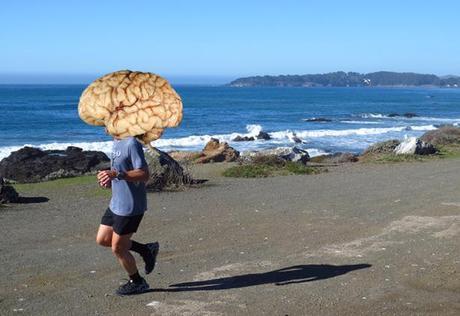
As a runner, it helps to have a really good brain on your shoulders
It’s late June, though it could just as easily be October or February. After all, the concept of seasons is largely an abstract one in Southern California. A light but steady breeze – a product of Venice High School’s proximity to the ocean – complements a stunning azure sky interspersed with sparse white clouds that seem the floating remnants of shredded cotton balls. It’s a perfect day to be outside… and a perfect day to be outside running.
Certain members of the Venice High Gondoliers football team may not agree. On the unkempt grassy field encircled by an unmarked dirt running track, sweat-soaked teenage boys in oversized navy-and-white practice jerseys run short sprints of ~20 yards each. This will be the last drill of today’s practice, and if body language is any indication, for many in this weary group the end can’t come soon enough. Players cross the finish line and then circle back slowly in an effort to secure as much rest as possible before repeating the ordeal. Hands rest on knees and faces contort in fatigued grimaces, as varsity hopefuls await their turn in perpetually moving lines that offer little respite. Two drill sergeants coaches oversee the operation – the first launches each wave of sprinters with a clipped “Go!” while the second stands at the 20-yard mark, urging his charges across the finish line with three strong-throated syllables: “Run through it!”
From my vantage point on the dusty track, rounding a turn on one of my drawn-out recovery laps, the scene feels awfully familiar. Adolescent memories harken me back to stifling summer days spent enduring similar {ahem} character-building experiences under the watchful eye of a questionably qualified coach. But what arouses my interest here isn’t nostalgia – it’s that barked command that awaits each group of sprinters at the finish line: Run through it! Three words that some kids take to heart, leaning forward and jutting their chest out as if to break an imaginary tape, whereas others clearly take their foot off the gas after no more than 15 yards.
It’s doubtful I’ve ever used the terms “high school coach” and “thought-provoking” in the same sentence – growing up in Texas, my 9th grade basketball coach clumsily sliced off three of his toes while mowing his lawn. But like Valvoline for the brain, that single coaching directive – Run through it! – lubricates my mental gears and gets me thinking:
Why do some runners attack the finish line like shark on seal, while others falter much earlier in the race? Why don’t we all “run through it”?
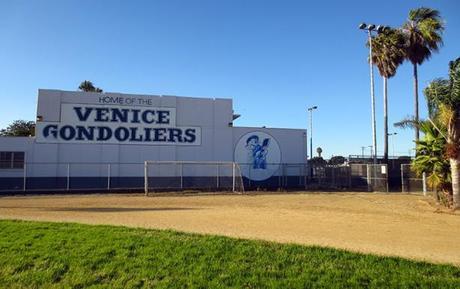
The mind is a powerful thing. It can take you through walls. – Denis Avey
Runners love their motivational quotes about always giving 100% (or for the mathematically challenged, 110%). But as inspiring as this sentiment is, the reality is that most of us will never come close. And that reality is a major reason why, in the hearts and minds of the running community, the legends of Alberto Salazar and Steve Prefontaine continue to grow long after the end of their storied racing careers.
Salazar – widely regarded as one of the greatest marathoners (and now coaches) of all time – was once read his last rites prematurely after collapsing at the finish line of the 7-mile Falmouth Road Race with a body temperature of 107°F. Salazar was able to filter out pain and push through perceived limits to an extent that very few runners can. Indeed, it was in large part this unwillingness to heed his own physiological signals that short-circuited his racing career due to illness, injury and burnout after his “Duel in the Sun” victory at the 1982 Boston Marathon at age 24.
Similarly, Prefontaine – whose competitive drive remains the stuff of legend 38 years after his premature death at age 24 – once famously said:
A lot of people run a race to see who is fastest. I run to see who has the most guts, who can punish himself into exhausting pace, and then at the end, punish himself even more…. Someone may beat me, but they’re going to have to bleed to do it.
And Pre was the authority on guts, having held the U.S. record at all seven track and field distances ranging from 2,000m to 10,000m. Clearly both men recognized mental fortitude (or “guts”) as their competitive advantage, an advantage they’d use to claim psychological victory over an exhausted opponent before ever reaching the finish line. An advantage they’d use to run through it.
So then is it the case that these two simply trained harder and were more genetically gifted than the rest of us, enabling them to dominate their competition? No doubt that’s a big part of it. But aside from easily defined measurables like lactate threshold and VO2 max, it was each man’s immeasurable psychological edge that ensured his eventual rise from “runner” to “champion” to “legend”.
Salazar and Pre’s singular ability to reach deep and run through it raises a tantalizing question: what if our own inability to push beyond perceived limits is based on a clever lie, meticulously crafted by our brains over evolutionary time scales, and fraught with lactic acid demons and muscle depolarizing goblins?
In effect, what if our brain is running the show? What might be possible, in terms of athletic performance, if we can override its self-imposed limits? Because recent evidence suggests an inconvenient truth of exercise physiology – namely, that the body has more to give than the mind is willing to admit.
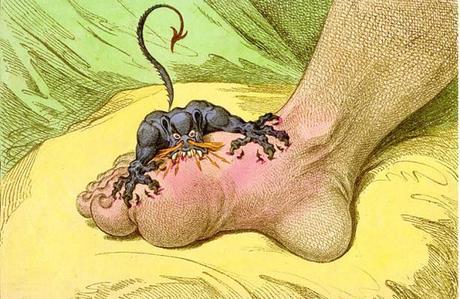
Although originally drawn as “The Gout” in 1799, with a little imagination this could be a lactic acid demon
Reality leaves a lot to the imagination. – John Lennon
In his book Incognito: The Secret Lives of the Brain, neuroscientist David Eagleman makes a compelling case for the dominant role of the subconscious mind in our everyday lives. Eagleman cites both experimental and anecdotal evidence to argue that the subconscious mind is the engine that drives our decision-making and which enables the entire machine to run smoothly. He writes:
Our brains run mostly on autopilot, and the conscious mind has little access to the giant and mysterious factory that runs below it…. The truth is that it’s better this way. Consciousness can take all the credit it wants, but it is best left at the sidelines for most of the decision-making that cranks along in your brain.
Extending Eagleman’s argument to running performance yields the provocative notion that the final frontier in exercise science may well be our ability to harness the power of our own subconscious… and to use that power to regulate the flow of information between mind and body.
Samuele Marcora would likely agree. Dr. Marcora studies fatigue and endurance performance as Director of Research at the University of Kent School of Sport & Exercise Sciences. His research into the causes of fatigue in endurance athletes have led him to conclude that rather than effort itself, it is the psychological perception of effort which induces athletes to quit before their physiological well runs dry. “Perception of effort” is basically a euphemism for “level of suffering,” so runners ultimately stop running not when they experience muscle fatigue, but when they feel they’ve suffered enough. By extension, anything that lowers perception of effort – smarter training, superior genetics, forgoing those last five beer-battered onion rings, etc. – will increase the likelihood of reaching the finish line faster.
Other observations, scientific and otherwise, support the “perception of effort” hypothesis. Negative thoughts and facial grimaces while running lead to a greater feeling of fatigue than a positive mindset and relaxed countenance. Running against competition raises one’s pain threshold compared to running alone. We’ve all experienced the “end spurt” phenomenon, that lactate-infused dash to the finish in the home stretch of a race. And most men can vouch for the fact that their mental fatigue and perception of effort both decrease dramatically under the watchful eye of an attractive female.
I don’t have far to look for my own practical example. The final interval of my speedwork sessions is usually faster than it has any right to be. Instead of reflecting a predictable deterioration in performance consistent with muscle fatigue, my last interval is frequently the fastest of the bunch. And that only makes sense if I’m (consciously or otherwise) holding something back – “chickening out” as Matt Fitzgerald bluntly puts it – to prevent the all-out suffering that would accompany an all-out effort. But once the imaginary coach in my head snaps “Go!” to start that final interval, all bets are off – because the sooner I reach the finish line, the sooner it will all be over. And the sooner those dissident voices in my head can turn their attention to dinner.
Now that we understand what “perception of effort” means and why it matters, what do we do with that information? One quote from Dr. Marcora’s 2010 interview with Fitzgerald sticks with me like mental mucilage: “If you didn’t have perception of effort, you could run your marathon much faster, definitely!”
So naturally the question becomes… how much faster? Fast enough for an elite runner to, say, run a marathon in less than two hours?
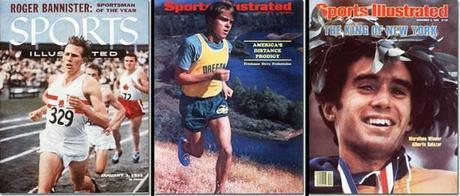
Deserving cover boys Roger Bannister (1955), Steve Prefontaine (1970) and Alberto Salazar (1980)
Physiology always wins the day. – Ross Tucker, Jonathan Dugas and Matt Fitzgerald (p. 187).
No question sparks a more lively debate among hardcore runners than “Will someone break the two-hour marathon barrier in our lifetime?” (although the prospect of a woman chasing the four-minute mile is intriguing in its own right). In many minds, the word “barrier” aptly describes the potential for a two-hour marathon performance. And while no less a runner than Ryan Hall believes it can be done, many well-reasoned data-driven arguments suggest it won’t… at least not anytime soon. Arguments citing the undeniable fact that no runner has ever clocked a sub-hour split – much less two – in the marathon, despite this having happened 178 times (for 89 different runners) at the half marathon distance. Arguments suggesting that marathon times have more or less plateaued, and that the world record is gradually approaching the uninspiring limit of… 2:02:43. And arguments pointing to the requisite (and admittedly mind-blowing) 5K and 10K “equivalent performances” as proof that a sub-two marathon ain’t happening in our lifetimes.
Granted a sub-two marathon doesn’t feel imminent – the current world record, set by Patrick Makau at the 2011 Berlin Marathon, stands at 2:03:38. Given that the record has dropped by only 2:27 in the past 15 years, two hours still feels like a distant target. Then again, nobody expected Paula Radcliffe to shatter the women’s world record by nearly 3-1/2 minutes when she clocked an astonishing 2:15:25 at London in 2003. But two analyses published in the Journal of Applied Physiology – one from University of Montreal mathematicians François Péronnet and Guy Thibault, and the other from Mayo Clinic physiologist Michael Joyner and colleagues – do foresee the marathon world record falling below two hours by 2040. And several of Hall’s elite colleagues – including U.S. teammate Meb Keflezighi, former world-record holder Haile Gebrselassie and London course-record holder Emmanuel Mutai – agree it’s not a matter of if, but when the two-hour mark will fall.
So then if you’re scoring at home, weighing the pros and cons of each side’s argument and taking all the data into account, the answer to whether we’ll see a two-hour marathon in our lifetime is a categorical, rock-solid maybe.
But keep in mind… before that spring day in 1954, when Roger Bannister ran four laps around a cinder track in 3:59.4, the four-minute mile was considered by many an insurmountable barrier. Turns out that barrier was actually more of a hurdle, and the floodgates were open – Bannister’s record quickly fell to Australian John Landy 46 days later, after which the mile record time would drop four more times in just over a decade. Clearly the four-minute mile “barrier” was more mental than physical.
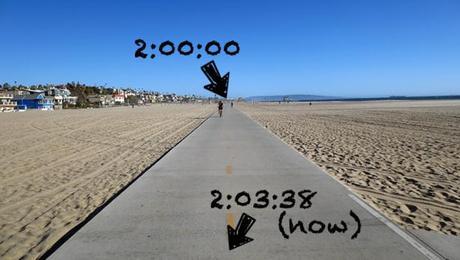
As you can see, a two-hour marathon is on the horizon (distance measured in SoCal units)
That’s your best friend and your worst enemy – your own brain. – Fred Durst
All that said, the future – the real future – of exercise physiology doesn’t lie in incremental improvements to our VO2 max or our running economy. It doesn’t lie in thrice-weekly interval workouts, or healthier eating, or improved stretching techniques, or radical advances in footwear technology, or increasingly elaborate (and expensive) tools for monitoring heart rate and metabolite levels… though these familiar themes should continue to keep Runner’s World in circulation.
Likewise, it doesn’t lie in bigger, better and harder-to-detect supplements that target every organ below the neck – supplements like erythropoietin (EPO) to produce more red blood cells, human growth hormone to increase muscle mass and speed healing, amphetamines and other stimulants (55-Hour Energy?), plus masking agents to dilute ‘em out and decrease the chances of getting caught. The introduction of the “biological passport” that ultimately led to Lance Armstrong’s downfall makes conventional performance-enhancing drugs a much riskier proposition for elite athletes.
No, my expectation is that the real future of exercise science lies not so much in the heart, lungs and legs (though we’ll want to hold on to those), but in the ability to modulate our perception of effort. If I may redirect the wisdom of former U.S. Defense Secretary and noted non-brain surgeon Donald Rumsfeld, the human brain is an untapped treasure trove of “known unknowns… things that we now know we don’t know.” But even more alluring to me are the brain’s “unknown unknowns… things we do not know we don’t know.” And while well-respected authors such as Matt Fitzgerald and Tim Noakes offer practical guidance on how we can train our brains to improve running performance today, I’m more intrigued by the boundless promise of tomorrow. Because as neuroscientists roll up their sleeves and poke around under the hood, what they learn about the brain will have game-changing implications for the future of the sport.
Luckily, cutting-edge approaches – non-invasive imaging technologies together with President Obama’s recently unveiled BRAIN Initiative to map the human brain – should offer a wealth of insight into how three pounds of squishy pink biomass governs athletic performance. Because if we’re to keep pushing the limits of human endurance, we need to know which regions of the brain control each stage of the race-day experience – from pre-race anxiety to onset of fatigue to post-race euphoria – and which neurons fire when we’re nervous, or relaxed, or focused, or overheated, or exhausted, or triumphant.
(This isn’t wishful head-in-the-clouds thinking on my part: similar brain-imaging studies are already being used to map the neural circuits that underlie feeding behavior, with the long-term goal of combating the nation’s obesity epidemic.)
With that toolkit of knowledge in hand the real fun begins, as neuroscientists and exercise physiologists fine-tune their neural tinkering in an attempt to manipulate – via drugs, electrical stimulation, meditation, or other – the pain-and-pleasure center of the brain. To limber up the limbic system, as it were. Because what if – to take the mechanic analogy one step further – we could disable the catalytic converter in our own brains? Might we desensitize our perception of effort, and coax out just enough of a performance boost for us to run our fastest mile, our best 10K, our speediest marathon? For an elite runner with world-class training and resources to run a sub-2 marathon? What a brave new world of performance enhancement that would be.
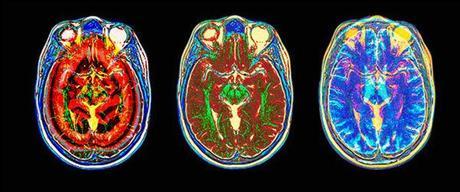
Brain imaging is the future of exercise science (MRI scans courtesy of Dana-Farber Cancer Institute)
Never was anything great achieved without danger. – Niccolò Machiavelli
This is a high-risk, high-reward proposition. To the victor go the spoils, and the first marathoner to break the tape in less than two hours – whether American (though probably not), British, Kenyan, Ethiopian, Eritrean or a citizen of Atlantis – undoubtedly will write his own ticket. The running community and the world at large will rightly genuflect before their modern-day Roger Bannister. Who knows, ESPN may even break into its own brain-draining Tiger Woods or New York Jets coverage to report the story! Or, it may not.
But the greatest resistance to a two-hour marathon will come between the ears of the person running it. Because like any good police force, the job of the mind is to protect and serve. And for that purpose it deploys powerful feedback mechanisms – mechanisms such as pacing, perception of effort and “anticipatory regulation” (discussed by Tucker, Dugas and Fitzgerald) – as protective strategies to keep the body from burning out five miles short of the finish line. Therefore, striving to override these mechanisms – or even tweak them – may be asking for trouble, and may even jeopardize racing careers in the same way that Alberto Salazar’s maniacal training regimen undermined his own.
In any case, physiological limits eventually collide with cold hard reality… all the motivational tools in the shed won’t help you beat a cheetah in the 100-yard dash. And it may ultimately be those physical limitations, including the body’s capacity to offset excessive heat production with sufficient heat loss, that determine if and when a human being runs 26.2 miles in less than two hours… and whether they’re still standing for the post-race interview. But one day, and hopefully in my lifetime, some supremely focused runner with a high-altitude background and the mental wherewithal of Bannister, or Salazar, or Prefontaine, will step up and make a legitimate bid for running immortality. And my guess is that when that happens, the operative word of the day will be “headstrong”.
Because if neuroscience has taught us anything, it’s that deceiving is believing. And with the right combination of physical stamina and mental fortitude, it’s only a matter of time before someone looks the two-hour marathon barrier straight in the eye, and refuses to blink. Before someone runs her mile in less than four minutes. Before someone does the seemingly impossible. Before someone runs through it.
But they still won’t give 110%.
What do YOU think is the limiting factor for a sub-2-hour marathon? How do you envision the future of exercise science? And what pun would you have used in the title of this post?
For a fantastic “State of the Union” on the two-hour marathon debate, check out this recent post on Dan’s Marathon.
And for those readers living in 2030, keep your eye on Berlin this weekend.
